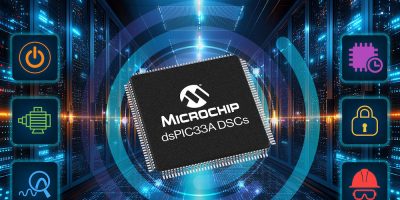Evolving security and functional safety demands, coupled with the growing complexity of real-time embedded applications, are driving designers to seek innovative solutions that deliver greater accuracy, improved reliability and compliance with industry standards. To address these challenges, Microchip Technology has added the dsPIC33AK512MPS512 and dsPIC33AK512MC510 Digital Signal Controller (DSC) families to its dsPIC33A DSC product line. The devices enable the implementation of computation-intensive control algorithms for improved energy efficiency in motor control, AI server power supplies, energy storage systems and complex sensor signal processing with Machine Learning (ML)-based inferencing.
The dsPIC33AK512MPS family delivers precise, high-speed control through 78 ps high-resolution Pulse Width Modulations (PWMs) and low-latency 40 Msps ADCs, enabling fast and accurate control loops essential for optimising the performance of Silicon Carbide (SiC) and Gallium Nitride (GaN)-based DC-DC converters. Additionally, dsPIC33AK512MPS devices include advanced security features, an integrated touch controller and a high pin count of up to 128 pins. The dsPIC33AK512MC family is designed to offer low-latency, 40 Msps ADCs and 1.25 ns PWM resolution, providing a feature- and cost-optimised solution for multi-motor control and complex embedded applications.
The dsPIC33A DSC families, with up to 512 KB Flash and a rich peripheral set, integrate a double precision floating-point unit to accelerate mathematical computations and leverage a 32-bit architecture for seamless adoption of model-based design code. Their enhanced instruction set and Digital Signal Processing (DSP) capabilities, including single-cycle MAC operations and a 200 MHz core speed, make these devices highly efficient for low-latency, real-time control applications. Supported by MPLAB Machine Learning Development Suite, dsPIC33A devices streamline the ML workflow by automating data preparation, feature extraction, training, validation and firmware conversion of optimized models.
With a range of hardware safety features, dsPIC33AK512MPS/MC DSCs are compliant with functional safety standards and are developed in accordance with International Organisation for Standardisation (ISO) 26262 and International Electrotechnical Commission (IEC) 61508 processes, making them suitable for safety-critical automotive and industrial applications. To further enhance system-level security, the dsPIC33AK512MPS DSC family includes integrated crypto accelerators and a Flash security module, enabling immutable root of trust, secure boot, secure firmware upgrades and secure debug capabilities.







